
AAC Device Tracking
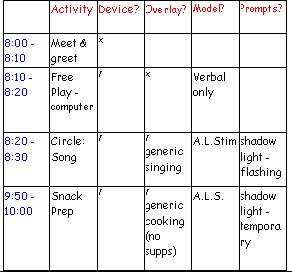
By: Caroline Musselwhite
This month's tip includes a tracking form for teachers, parents, and therapists to use to build accountability by recording observations relating to when and how AAC systems are being used. The pdf documents include a more indepth write up on this process, a blank tracking form and a sample of a completed form.
January 2006
return to top

Moving and Grooving and Talking!
Movement Activities to Support Language Learning
 |
These activities are set up to support students in engaging in motor activities to enhance motivation, support language learning (especially vocabulary and concept development, and direction-following), and serve as a valve for excess energy! Enjoy!
|
February 2006
return to top


|
Talking Everywhere
The idea for this tip is from Pam and Josh Harris. Pam has created innovative light tech displays that are located throughout the house. This includes backup displays of the main board for her son’s communication device and/ or activity-based displays. Two ideas for affixing displays are to print them on stickyback decal paper (mount in shower, on bathroom wall, etc.) or on magnetic backed paper (mount on refrigerator). Happy talking . . . everywhere! |
March 2006

return to top

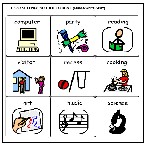
Story Scripts
By: Caroline Musselwhite
Story scripts are one type of conversation scripts described by Musselwhite & Burkhart (2004). This tip gives ideas for who should be practicing story scripts, and provides sample scripts. More information is available in the Can We Chat book and CD (carmussel@cox.net).
April 2006

return to top
Collections: by Caroline Musselwhite
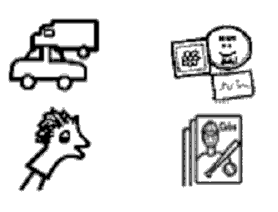
This is a tip to support initiating simple conversations for individuals with significant cognitive delay. Collections are great because:
-
they support developing a sense of belonging (we ALL have collections!)
-
they support changing perceptions of partners
-
they are very concrete
-
they are FUN!
ENJOY!
May 2006
return to top

Mealtime Placemat

We all know that mealtime is a GREAT time to model and support communication for many AAC users. Placemats are a terrific way to supplement device use with light-tech use of symbols (especially for messy times when we don’t want dirty fingers smudging up the communication devices). This tip shows two versions of snack placemats, and describes strategies for modeling interactive language during snack or mealtime.
Enjoy!
June 2006

return to top

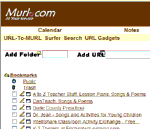
Songboard Websites courtesy of MURL
Looking for good websites that have lesson plans and songboards? Have you ever wished someone else would do the hunting for you? If so, then this tip is for you. This tip comes from Mary Keeney, SLP extraordinaire and Songboard Queen!
July 2006

return to top

Initial Letter Cueing Tip
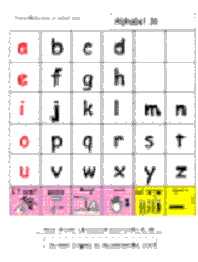
Initial Letter Cueing is an idea from David Beukelman and Kathryn Yorkston, first published in (1977). Initial letter cueing is an alphabet supplementation approach intended for people whose speech is currently difficult to understand, but who would be more intelligible if the speaker indicates (e.g., by pointing) the first letter of each word s/he says. This tip is a great example of the adage that ‘Everything old is new again.’ If you havn’t tried it, you’ll be amazed at how well it works for some students!
August 2006

return to top

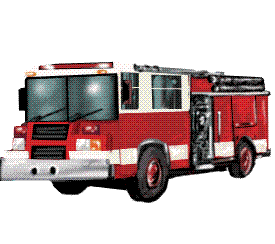
Fire House Stories
Get out your lights and sirens! Hot off the press! Here are some more simple stories. These were written by teachers & therapists at Buckeye Elementary School in Arizona on a Friday afternoon after a long week! (And they are still wonderful... proves what a combination of determination, imagination, collaboration, and inspiration will do!) Enjoy!!
September 2006

return to top

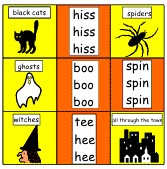
A "Halloweeny" Version
We know you love ‘Wheels On the Bus’ . . . but isnt’ it ready for a MAKEOVER?? This tip shows how to adapt ‘Wheels’’ for Halloween. Instead of wipers and babies, this bus has black cats and ghosts!! It’s a great example of repetition with variation. Enjoy!!
October 2006

return to top

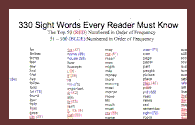
High Frequency Words!
This month’s tip is a list of high-frequency words developed by the Start-to-Finish team, who have developed the Start-to-Finish book series (www.donjohnston.com ). High-frequency word lists abound in the world of education, but this one is useful for three reasons:
-
The list is large enough to support readers beyond first grade, but small enough not to be too daunting
-
It presents the top 50 and top 100 most frequently occurring words in order of frequency
-
Knowing this list means knowing about 60% of the running words in any book.
Download this list, plus Do’s and Don’t’s for using it!
(Word List included)
November 2006

return to top

Regional Geography Writing

This tip comes from workshop participants in Baton Rouge, LA and Whitby, Ontario. They wrote simple ‘transitional’ stories about the geography of their regions. Read these for ideas for story-writing for YOUR region! See the January, 06 Tip of the Month for more story-writing ideas!
December 2006





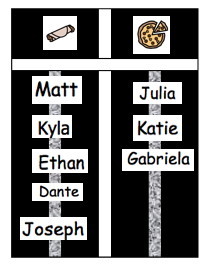
 Tip of the Month 2010
Tip of the Month 2010























